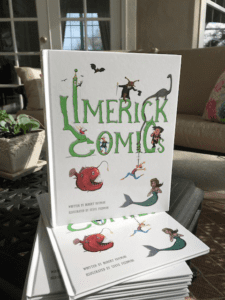

Today, Feathered Quill reviewer Holly Connors is talking with Robert Hoyman, author of Limerick Comics.
FQ: As I mentioned in my review, I love the fun and playful nature of your book. What drew you to limericks and why did you dedicate your first book to them?

HOYMAN: The idea for creating Limerick Comics was born of necessity. In the early 90s, I brought from home a book that my own two sons found particularly entertaining. It was A Book of Nonsense by Edward Lear, the quintessential British author, illustrator, and poet presenting the superb form of limericks that he popularized. As expected, my students were delighted by the humor and downright silliness. As soon as we were finished and we had run out of limericks, the kids pleaded for more.
Eager to advance their enthusiasm for learning, I headed for the school library, the public library, and the local bookstores. Surprisingly, I could find no books featuring limericks for children. At the time, in my experience, it appeared that the genre was underrepresented. As a result, I began writing my own. But my personal interest was to write about meaningful topics we encountered along the way in Science and Social Studies. The students enthusiastically created the illustrations.
In the succeeding years, I routinely shared my limericks with my students. In school districts from California to Florida, the reaction was consistent. The students were enchanted by the humor, captivating stories, and goofy illustrations. It became clear that upon retirement I would polish my old limericks, write new ones, provide a fascinating accompaniment of fun facts to inspire discourse between teachers or parents and kids, and find a brilliant illustrator to create evocative comics. The result was my debut book Limerick Comics.
FQ: How long does it take to write a single limerick? Do they come to you quickly or do they need to rummage through your head a bit before they come to life?
HOYMAN: For me, it takes a good long while. Typically I can get the first two lines and a fair idea for the direction of the story. The next three lines take more time to emerge. The final line is crucial because it serves the purpose of resolution and often story clarity. Occasionally I use it to offer an intriguing inference explained further in the nonfiction sixth panel. Some have used the fifth line of a limerick to restate the first, but I find it essential to help tell the story because five lines are restrictive enough. I really embrace the process of crafting a limerick poem with a strict adherence to anapest meter working within the constraints of word choice imposed by the number of syllables and placement of the accent. That’s the real challenge. So I ponder individual limericks for days slowly taking shape wherever I might be. I try to swim each day at our community pool nearby. While relaxing at the pool, more than once the words and phrases that fit just right beckoned, unforced, and I had to jump on my bike and pedal home frantically to write them down before they faded away.
FQ: The topics of the limericks in Limerick Comics are so varied. How did you choose the subject matter?
HOYMAN: The topics were all gathered along the way throughout my teaching journey. I chose the subject matter that I found fascinating, but I also included many topics that I remember eliciting interest, intrigue, and curiosity in my students. Some limericks were built around introducing a particular concept like bioluminescence, gastroliths, or the unusual fact that octopuses possess three hearts. Others address the natural expression of curiosity found in children. They’re always wondering where things came from. These can range from the origin of colossal roller coasters to something quite ordinary like cement.
FQ: Is there a chance you have a stash of limericks that you couldn’t fit into this book and that might make an appearance in a sequel?

HOYMAN: Yes, I have a number of them but many didn’t make the cut because they are comical and goofy. Although entertaining, they lack any educational value. I can envision someday putting them out there perhaps with a single amusing hyperbolic illustration to induce a few guffaws. However, there’d certainly be no need for a sixth panel.
FQ: When you write up a limerick, do you picture the images that will accompany the verse?
HOYMAN: Not with any great detail. I concentrate on writing a complete story with only a vague sense of the imagery. After endless revisions, I found it exhilarating finally turning the manuscript over to Steve Feldman then anxiously waiting for him to breathe life into my goofy characters.
FQ: Along the same lines, tell our readers about the process of working with your illustrator, Steve Feldman. Are you very specific about what you want for each limerick? How you want the images to appear? Colors, facial expressions, etc., or do you discuss the basics with Mr. Feldman and then let him go wild?
HOYMAN: Collaborating with Steve Feldman was a thoroughly enjoyable experience for me. Having recently retired after 40 years of teaching, the daily back and forth by email was a stimulating and invigorating learning experience. Our goal was to produce a book of outstanding quality with an elegant appearance worthy of the coffee table. Steve is not only a supremely gifted artist and illustrator, but he is also the consummate professional. I like to think that I was wise enough to turn over the revised manuscript to Steve and get out of the way. I deferred to his artistic vision. I felt that we could achieve a quality result if he felt unencumbered and just had fun with it. I believe he did find the process enjoyable and the range and diversity of the subject matter really allowed Steve to showcase his versatility as an artist. Jokingly, I told him to recall his days in Jr. high school when he was drawing comics in his notebook instead of paying attention in class.
FQ: Authors are often asked if they have a favorite book among the books they’ve written. Do you have a favorite limerick?
HOYMAN: Not really. They’re like my two sons. I love them equally while appreciating their unique qualities. Like anyone, I find the subject matter in some more interesting than others. However, I guess if I was forced to pick one King Tut always brings a chuckle. “At nineteen no pharaoh was cooler.”
FQ: I see from your author bio that you’re a member of SCBWI. Would you tell our readers a bit about this organization and why you’re a member? Would you recommend other debut authors join?
HOYMAN: Society of Children’s Book Writers and Illustrators is a nonprofit organization specifically for those who write for children and young adults. Their mission is to support the creation of quality children’s books around the world. Membership is open to anyone with an active interest in children’s literature. They sponsor conferences, workshops and many other events. The message boards, webinars, blogs, and local chapters make available a network of support opportunities like guidance, information sharing, critique groups etc. It has been tremendously helpful to me as I began to learn more about the writing industry and community.
FQ: While your career in teaching continued for over four decades, you also produced and directed numerous musical plays. Do you miss the creative process of theater and do you think you’d ever get involved in another play?
HOYMAN: I miss the creative process of theatre immensely. It was among the most gratifying experiences in my teaching career. I loved challenging fourth and fifth graders to learn 40 pages of script, 6 songs, and then witnessing the students use their unique, evolving skill-set to create memorable characters. They learned fluency and problem-solving in an authentic and natural way. They returned home from school each day after rehearsal singing a happy tune. I can still see their eyes when the curtain closed on opening night reflecting the look of pure relief, pride, elation, and confidence in the making. I have since encountered several of the former cast members. Not once have they recalled a top score on a state-mandated test, but all share fondly the joy and lifelong memories cherished from our musicals. Now that I’m retired, I can’t envision involvement in another play. I’ll just continue to turn to writing.
FQ: Is there another book of limericks in your future or do you think you’ll try another genre?
HOYMAN: I’ve been researching a project that is likely to result in a juvenile biography or historical fiction. I feel passionate about the need for this story to be told. Perhaps later, I’ll publish the batch of limericks referenced earlier.
Disclosure in Accordance with FTC Guidelines 16 CFR Part 255
Copyrights © 2023 Feathered Quill Reviews All Rights Reserved. | Designed & Developed by Unglitch.io